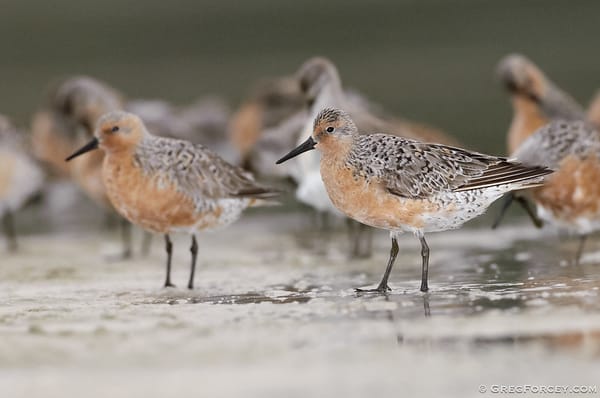Double-observer Point Count Comparison
My Master’s work compared two different double-observer point count methods for surveying birds. The approach where both observers worked together performed better than the approach where observers worked independently.

Background
Many bird counting methods exist for determining species and relative abundance. The most popular bird survey method is the point count, where an observer stands in a single location and counts all birds seen or heard within a defined time interval (usually 5–20 minutes). Point counts are efficient, and the preferred approach for rugged terrain since visual and audible detections are recorded.
Point counts done by a single observer cannot be used to calculate species-specific detection probabilities; therefore, it is not possible to account for birds that may be present but not detected. A detection probability represents the probability of detecting a bird, given that it is conspicuous (not hiding or silent). One way to calculate detection probabilities for each species is to use two observers to conduct a point count. Using two observers permits researchers to account for birds present but not detected and produce more reliable abundance estimates.
For my Master’s research, I compared species-specific detection probabilities and model performance from data collected using two different double-observer point count methods. I also compared the survey efficiency and feasibility of implementing both methods in the field as part of the evaluation.
Methods comparison
Single-observer point count
The traditional bird point count involves one observer doing the bird counting and data recording as birds are detected. An observer travels to a pre-defined survey location (point), remains in that position for a set interval, and records all birds seen or heard within an estimated distance interval. All visual and audible bird detections are recorded if they are detected in the pre-defined point count radius. After each count, the observer moves to the next point and conducts another survey using the same method. This survey approach continues until around 11:00 AM local time, when bird activity typically decreases.
Dependent double-observer point count
The dependent double-observer point count method uses two observers communicating with each other during the count (dependent on each other). The primary observer identifies and verbally calls out (and points to) all birds seen or heard within defined time and distance intervals at the point count location. The secondary observer records all the observations dictated by the primary observer; the secondary observer also records birds missed by the primary observer. Each observer alternates roles between the primary and secondary observer as new points are surveyed.
Independent double-observer point count
The independent double-observer point count method also uses two observers. Each observer conducts the same point count but records data independently without verbal communication between each other. After each count, observers discuss species and locations to determine which individuals were detected by each observer, which is necessary for the data analysis. This requirement makes misidentified birds from one observer more problematic when analyzing data from this method. Performing the between-observer discussion after the point count also requires additional field time and reduced efficiency.
Results
The single-observer approach involves lower personnel costs but does not permit the calculation of detection probabilities to account for birds present but not detected. The method also risks missing birds while the single observer is recording data.
The dependent double-observer approach permits a species-specific detection probability that accounts for birds present but not detected. This method generated higher detection probabilities compared to the independent double-observer method. The dependent double-observer method is also beneficial because observation and data recording responsibilities are partitioned; thus, observers are less likely to miss birds during the count. However, a downside of the dependent double-observer method is the higher labor costs due to needing a second observer.
The independent double-observer approach permits the calculation of detection probabilities, but they were lower than those from the dependent double-observer method. The independent double-observer method also does not partition bird observation and data recording responsibilities into separate roles; thus, the chance of missing birds is higher. The independent double-observer method is also costly because two field biologists are required; however, the independent double-observer method also requires discussing each observer’s detections at the end of the count, which further increases time and labor costs.
| Criteria | Single-observer | Dependent double-observer | Independent double-observer |
|---|---|---|---|
| Labor requirements | Low | High | High |
| Account for undetected birds | No | Yes | Yes |
| Better detection by partitioning responsibilities | No | Yes | No |
| Risk of misidentifications affecting estimates | Medium | Low | High |
One major limitation when evaluating the effectiveness of two different survey methods is that the true number of birds at each count location is unknown. Thus, it is impossible to say which approach generates more accurate abundance estimates. Instead, I compared the two methods by evaluating detection probabilities and each method’s feasibility in a field setting.
Recommendations
The dependent double-observer method is preferred and recommended for point count surveys over the independent double-observer method. The dependent double-observer method’s advantages over the independent double-observer approach include the following:
- Higher detection probabilities with lower standard errors.
- Fewer issues with misidentified birds
- It doesn’t require independence between observers, thus easier to implement in the field
- Less likely to miss birds during the count as one observer is dedicated to bird counting and the other is dedicated to data recording
Despite this recommendation, point counts are not the best bird survey approach in all cases. Depending on the habitat and goals of the surveys, other methods such as removal modeling, distance sampling, and double sampling may be more appropriate. Researchers should carefully consider the study goals before selecting a bird survey method.
References
Forcey, G. M., J. T. Anderson, F. K. Ammer, and R. C. Whitmore. 2006. Comparison of two double-observer point-count approaches for estimating breeding bird abundance. Journal of Wildlife Management 70:1674–1681. https://wildlife.onlinelibrary.wiley.com/doi/abs/10.2193/0022-541X(2006)70[1674:COTDPA]2.0.CO;2/





